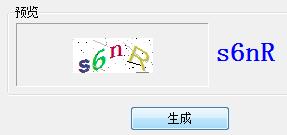验证码生成器(在TImage.Canvas上写字,很好看)
Posted 朝闻道
tags:
篇首语:本文由小常识网(cha138.com)小编为大家整理,主要介绍了验证码生成器(在TImage.Canvas上写字,很好看)相关的知识,希望对你有一定的参考价值。
生成验证码的方式有很多种,如下则是比较简单的实现,且运用了正余弦曲线来扭曲验证码字符。
unit AuthenticodeGenerate;
interface
uses
SysUtils, Windows, ExtCtrls, Graphics;
function GenerateAuthenticode(const Img: TImage; const Len: Integer = 4): string;
implementation
const
cCharDigitArrayLen = 6;
cCharDigitArray : array[0..cCharDigitArrayLen - 1] of Char = (\'3\', \'4\', \'5\', \'6\', \'7\', \'8\');
cCharLowerLetterArrayLen = 13;
cCharLowerLetterArray: array[0..cCharLowerLetterArrayLen - 1] of Char = (\'b\', \'c\', \'e\', \'h\', \'j\', \'k\', \'m\', \'n\', \'s\', \'t\', \'v\', \'w\', \'y\');
cCharUpperLetterArrayLen = 19;
cCharUpperLetterArray: array[0..cCharUpperLetterArrayLen - 1] of Char = (\'A\', \'B\', \'C\', \'E\', \'F\', \'G\', \'H\', \'J\', \'K\', \'L\', \'M\', \'N\', \'P\', \'Q\', \'R\', \'S\', \'V\', \'W\', \'Y\');
cArrayTypeNum = 3;
cFontNameNum = 5;
cFontNameArray: array[0..cFontNameNum - 1] of string = (\'Arial\', \'Tahoma\', \'宋体\', \'幼圆\', \'微软雅黑\');
function TwistImage(const SrcBmp: TBitmap; XDir: Boolean; MultFactor: Double; Phase: Double; SinTrick: Boolean): TBitmap;
const
cTwicePi = 6.283185;
var
BaseAxisLen : Double;
I, J : Integer;
DestX, DestY: Double;
OldX, OldY : Integer;
Color : TColor;
begin
Result := TBitmap.Create;
Result.SetSize(SrcBmp.Width, SrcBmp.Height);
if XDir then
BaseAxisLen := Result.Height
else
BaseAxisLen := Result.Width;
for I := 0 to Result.Width - 1 do
begin
for J := 0 to Result.Height - 1 do
begin
if XDir then
DestX := (cTwicePi * J) / BaseAxisLen
else
DestX := (cTwicePi * I) / BaseAxisLen;
if SinTrick then
begin
DestX := DestX + Phase;
DestY := Sin(DestX);
end else
begin
DestX := DestX + Phase;
DestY := Cos(DestX);
end;
if XDir then
begin
OldX := I + Round(DestY * MultFactor);
OldY := J;
end else
begin
OldX := I;
OldY := J + Round(DestY * MultFactor);
end;
Color := SrcBmp.Canvas.Pixels[I, J];
if (OldX >= 0) and (OldX < Result.Width) and (OldY >= 0) and (OldY < Result.Height) then
Result.Canvas.Pixels[OldX, OldY] := Color;
end;
end;
end;
procedure NoiseImage(const Img: TImage);
const
cNoiseLineNum = 5;
cNoisePointNum = 50;
var
I: Integer;
X: Integer;
Y: Integer;
begin
for I := 0 to cNoiseLineNum - 1 do
begin
Img.Canvas.Pen.Style := psSolid;
case Random(3) of
0: Img.Canvas.Pen.Color := clBlack;
1: Img.Canvas.Pen.Color := clGray;
else
Img.Canvas.Pen.Color := clSilver;
end;
X := Random(Img.Width);
Y := Random(Img.Height);
Img.Canvas.MoveTo(X, Y);
Img.Canvas.LineTo(X + Random(Img.Width - X), Y + Random(Img.Height - Y));
end;
for I := 0 to cNoisePointNum - 1 do
begin
case Random(3) of
0: Img.Canvas.Pixels[Random(Img.Width), Random(Img.Height)] := clBlack;
1: Img.Canvas.Pixels[Random(Img.Width), Random(Img.Height)] := clGray;
else
Img.Canvas.Pixels[Random(Img.Width), Random(Img.Height)] := clSilver;
end;
end;
end;
function GenerateCharacterAuthenticode(const Img: TImage; const Len: Integer = 4): string;
var
I: Integer;
V: Char;
X: Integer;
Y: Integer;
L: Integer;
begin
Result := \'\';
for I := 0 to Len - 1 do
begin
case Random(cArrayTypeNum) of
0:
begin
V := cCharDigitArray[Random(cCharDigitArrayLen)];
Result := Result + V;
end;
1:
begin
V := cCharLowerLetterArray[Random(cCharLowerLetterArrayLen)];
Result := Result + V;
end;
else
begin
V := cCharUpperLetterArray[Random(cCharUpperLetterArrayLen)];
Result := Result + V;
end;
end;
end;
L := 2 + Random(2);
Img.Picture := nil;
for I := 0 to Length(Result) - 1 do
begin
Img.Canvas.Font.Size := Random(5) + 17;
Img.Canvas.Font.Color := RGB(Random(256) and $C0, Random(256) and $C0, Random(256) and $C0);
case Random(3) of
0: Img.Canvas.Font.Style := [fsBold];
1: Img.Canvas.Font.Style := [fsItalic];
end;
Img.Canvas.Font.Name := cFontNameArray[Random(cFontNameNum)];
X := Random(4) + L;
Y := Random(2) + 4;
Img.Canvas.TextOut(X, Y, Result[I + 1]);
L := X + Img.Canvas.TextWidth(Result[I + 1]) + Random(2);
end;
if Random(2) = 0 then
begin
if Random(2) = 0 then
Img.Picture.Bitmap := TwistImage(Img.Picture.Bitmap, True, 8 + Random(3), 1 + Random(2), True)
else
Img.Picture.Bitmap := TwistImage(Img.Picture.Bitmap, False, 8 + Random(3), 1 + Random(2), True);
end else
begin
if Random(2) = 0 then
Img.Picture.Bitmap := TwistImage(Img.Picture.Bitmap, True, 8 + Random(3), 1 + Random(2), False)
else
Img.Picture.Bitmap := TwistImage(Img.Picture.Bitmap, False, 8 + Random(3), 1 + Random(2), False);
end;
NoiseImage(Img);
end;
function GenerateAuthenticode(const Img: TImage; const Len: Integer): string;
begin
Result := GenerateCharacterAuthenticode(Img, Len);
end;
initialization
Randomize;
end.
调用很简单:
uses AuthenticodeGenerate; procedure TfrmMain.btnTestClick(Sender: TObject); begin lbl1.Caption := GenerateAuthenticode(img1); end;
于是就有:

注:
1)、为减少识别难度,去掉了几个不易识别的字符如 1、I 等;
2)、验证码背景色当然也可以(应该)随机。
http://www.cnblogs.com/ecofast/p/4224016.html
以上是关于验证码生成器(在TImage.Canvas上写字,很好看)的主要内容,如果未能解决你的问题,请参考以下文章
